Vintage garage kit catalog
It’s 1985. You’ve watched all of Armored Trooper Votoms, spinoffs are in the air, and you’ve built every model kit Takara, Union, and Kabaya have to offer. But the gaps in the lineup are endlessly frustrating. Why did some models get released in one scale, but not the other? Why did some models not get released at all? Votoms is a beloved show. What in the name of Wiseman is the problem here???
Part of this is explained by timing. Most products get released in the first few weeks or months of a new show, then trickle off as new shows divert manufacturing attention. Also, a robot that gets introduced in later episodes (like the Fatty or the Zwerg) won’t have as much screen time as their predecessors, so it doesn’t make financial sense to invest in new product development for a show that will be off the air in a few weeks.
But none of those reasons satisfy the urge to fill in those gaps. Fortunately, there are other sources to turn to if you know where to look.
So what’s a garage kit? Simply put, it’s a term that was coined for models created by small, independent companies (rather than major corporations) that started in their garage workshops, basements, and living rooms and went on to form a significant new industry. To all indications, the mania began in the 70s when the “just for kids” mentality in the plamo industry gave way to a desire for increased detail, accuracy, and quality. It started mainly with military modelers who wanted to build obscure variants or prototypes and had to puzzle out techniques to form their own custom parts for existing kits.
Mass-produced plamo were (and still are) far too expensive for individuals to produce, since the dense metal molds have to stand up to several thousand impressions and are manufactured to a very high standard. More affordable techniques for home hobbyists began with vacuum-forming, but when RTV (Room Temperature Vulcanizing) rubber came into fashion, they discovered it could serve as an excellent mold for more than just customized parts. Some creative individuals took this as their cue to start producing entire kits from top to bottom. The rubber could only hold up to a few hundred impressions before it began losing its shape, but that was no problem if you only expected to find a few hundred customers.
The molds were the first hurdle, the material was the second – and polyurethane resin was the material of choice, easy to pour and cure and capable of reproducing a high level of detail. Resin kits are a little trickier to build than their mass-market counterparts (most of them don’t come with pegs, tabs, or slots and can’t be bonded with standard model cement), but an enormous range of specialty products has grown up around the hobby and a dedicated modeler now has access to just about every tool or material they could ask for.
The thing that makes garage kits so vibrant and interesting is that they reflect the interpretations of individual sculptors who evolve a concept from 2D to 3D. Exactly like cover songs, each interpretation can have its own unique flavors and still be true to the original. For example, if you prefer your Scopedog to have a tapering body, the Volks kits will suit your taste. A leaner body? Try Kotobukiya. Boxy? Head over to Wave.
Garage kit manufacturers in Japan assemble several times a year at various hobby shows to sell their carefully-handcrafted works, and Votoms is always well-represented. The kits are similar to doujinshi (fanzines) in terms of license and copyright. Some are officially sanctioned, but only on a limited basis for specific events. This naturally makes the kits difficult to obtain outside Japan except via online sources. But thanks to those, we can go on an extensive visual tour of Votoms garage kits.
Thanks to popular series like Votoms and its mecha brethren, the garage kit industry has grown exponentially in the years since 1985. Tiny companies have grown into big ones with their own boutique-style stores. Big companies have adopted garage kit techniques to manufacture limited-edition items with very high quality standards. It used to be that resin or soft vinyl kits had to be built in fixed poses since they didn’t come with moveable joints, but that’s changing now, too.
At their best, garage kits can go places mainstream companies fear to tread. A company named Volks still holds the record for the largest Votoms model ever produced, an enormous 1/8 scale Scopedog (standing about 20″ tall) with as many bells and whistles as it can hold. It cost several hundred dollars, severely limiting its customer base, but still stands above all others (literally!) as a prime example of what can be achieved with the right blend of innovation and passion.
Packaging has also come a long way, as you’ll see in these photo collections. The earliest products were no-frills, with either a simple graphic or photo on the box. But some of the more established companies, Max Factory for example, went all out with newly-commissioned box art rivaling anything from Takara. In many cases, the box art is part of the excitement, especially if you can only view these from afar.
Collected here are over 150 products from nine different manufacturers. This is a “vintage” catalog because it only goes up to the year 2000. Many, many more players have joined the game since then and the numbers continue to rise; as of this writing almost 200 more garage kits are waiting to be organized. So be on the lookout for a volume 2.
Read more about garage kits here and here.
Garage kits for the Blue Knight Berserga series can be found in their own galleries here.
Photo Galleries
Discussion of Votoms Modelers
from A.T. Votoms Complete Record Collection 1:
Votoms Bible (Published by Kisousha, September 2001)
There are people who are fascinated by Armored Trooper Votoms. What is the appeal of this work that has not faded away for either the sender and receiver, even after its completion? The endless and passionate talk of Votoms lovers who gathered here under the keyword “models” will help us explore the essence of this work.
THE PARTICIPANTS
1. Tsutomu Yamazaki
Yamazaki was involved in product development at Lark, the predecessor of Wave Inc. After that, he worked as the manager of the garage kit specialty store Wave PX and was actively involved in promotion of Votoms at the store. He has been the driving force behind the Votoms movement in hobby media. He is currently the president of Yamazaki Corporation, a printing and bookbinding company. In addition to his busy schedule, he also makes use of his personal connections to cooperate in various projects such as this round-table discussion.
2. Kenichi Nomoto
Pro modeler. For 15 years, he has been writing articles on modeling for Hobby Japan magazine. He is also known as the “Votoms Master” and has many examples of Votoms-related works. Since 1988, he has been producing AT garage kit prototypes for Wave, mainly in 1/35 scale. He is also in charge of parts prototyping for the company’s 1/24 scale Votoms series. Of course, he also works on many models other than ATs.
3. Masakazu Ohwa
Pro modeler and CEO of MO-Craft Co. Specializes in 1/48 resin cast garage kits. He is currently developing a full lineup of the Votoms series with an extensive collection. He writes for B-Club, Hobby Japan, and other model magazines. In recent years, he has also developed a new kit series for “Seikoku 1092”. He is active in various modeling events.
4. Masaaki Okajima
Freelance writer. He has written for game magazines at Shinseisha, making his debut as a freelance writer. He is the author of Votoms Alive (Ota Publishing Co., Ltd.) Great Mechanics and its sequel, Great Mechanics 2 (both published by Futabasha). [Translator’s note: these mooks were the genesis of Great Mechanics magazine, still in print today.] He has expressed his passion for Votoms in his writing. This time, he attended the meeting with a special scopedog, built for Great Mechanics 2. He also writes about various subjects other than Votoms.
5. Koichi Takazawa
Garage kit maker, head of Wave’s Development Dept. in charge of Votoms-related projects. Previously, he was in charge of F1-related kits. In this round-table discussion, he shared his valuable materials from the Lark era, his testimony as a development staff member, and his experiences in the development of Votoms. He also provided the venue for the round-table discussion. His latest work, a 1/24 Dog Carrier, is highly anticipated by fans.
The dawn of AT garage kits (1985-86)
Yamazaki: Talking about how Votoms product came about, Masahiro Oda (note 1) and Mr. Abe, the president of Lark (the predecessor of Wave) were talking about Votoms as their next new product. This was where Votoms garage kits started out. In a situation where various anime mecha were being made into garage kits, Votoms was the only one that had been broadcast on TV but didn’t yet have any released. I think Lark was the first to make a garage kit of an anime robot. So, they decided to make a cast kit of the Fatty and Rabidlydog modification parts. They appeared in Dual Magazine (note 2) and were well received, so they decided to do more.
Okajima: I bought a Zwerg. It was too hard to build. (Laughs)
Yamazaki: Max Factory (note 3) made a 1/24 scale Bloodsucker and Turbo Custom and commercialized them.
Takazawa: Did you do anything for Wave at the event?
Yamazaki: Oh, we released a 1/35 scale Rabidly and Berserga DT modification parts for Takara’s kit. To be honest, I put them out because I wanted them for myself. (Laughs) It was a product that was in tune with what both I and my customers wanted. I think this is how the Votoms garage kits started.
Note 1: Masahiro Oda/pro modeler. He was the driving force behind the Gundam plamo boom in magazines such as Hobby Japan and Comic BonBon.
Note 2: Dual Magazine/a hobby magazine launched in 1982 by Takara, a toy company. Ceased publication with the 12th issue.
Note 3: Max Factory/garage kit brand by Max Watanabe.
The blank period (around 1987)
Yamazaki: The popularity of garage kits spread to various people, but nothing new was done with Votoms since The Last Red Shoulder (1985). We didn’t have much, and Big Battle (1986) was…
Okajima: …it didn’t really take off.
Yamazaki: But the popularity of garage kits was growing. Megazone 23 (note 4) was quite successful. I was also involved in the Dunbine soft vinyl series and Layzner, I had just launched the Five Star Stories project, which is still a pillar of Wave’s work…then I quit the company.
Okajima: You just left. (Laughs)
Yamazaki: Yes, I did. (Laughs) So the people who came in later had to digest it, and they may not have been able to get around to Votoms anymore. So actually, after Max Factory’s 1/24 Turbo Custom, there was Mr. Nomoto’s 1/35 version for Roots of Ambition (1988).
Nomoto: That was my first job at Wave. It is true that there was a long interval after the 1/24.
Note 4: Megazone 23/an early OAV produced by AIC Inc. Three works were released between 1985 and 1989.
Blue Knight Berserga Story (circa 1988)
Nomoto: Around the same time I did the 1/35 Turbo Custom, I did a model of Blue Knight for Hobby Japan magazine. Wave also started to make Blue Knight kits, around the time of the third or fourth novel.
Yamazaki: The Blue Knight kits were temporarily suspended due to rights issues.
Ohwa: The first Shadow Flare kit was never released, was it?
Takazawa: No, it never came out. After that, Max Factory and Lark started a brand called L-Max. Their first two items were from Blue Knight.
Nomoto: At that time, Hobby Japan didn’t serialize the AT designs from the Blue Knight books, but every issue had a modeler who built the ATs in 3D. The novels and models were in sync. The second Blue Knight special from Hobby Japan was almost entirely filled with 3D models. It was a very exciting time for Votoms even though there was no new anime.
Roots of Ambition (circa 1989)
Yamazaki: Mr. Nomoto did prototypes of a 1/35 Turbo Custom and Fatty…
Nomoto: Mr. Fujita did the Bloodsucker. Ecrevisse came a little later.
Yamazaki: Around that time, I went back to Wave, and I was given the freedom to do whatever I wanted. The Roots of Ambition OAV was out then. At first I refused to watch it, but when Votoms was the only event I could think of for the store, I decided to watch it. “It’s good! Votoms is still cool! Let’s do an event!” It was around the time that Mr. Nomoto was working at Wave as a prototype designer, and I asked him if he had any ideas. He said he had made parts for the Red Shoulder Custom TV version, so I said, “Let’s sell them.”
Nomoto: It was originally shown in Hobby Japan, and was made to attach to a 1/24 Scopedog kit. I made it privately and displayed it at Wonder Fest (note 5) once or twice around 1988. I lent it to Wave’s event. Later, it was passed around and became the prototype for the 1:24 injection kit (note 6).
Yamazaki: I also talked to Mr. Fujita, the prototype designer, about the Hell Missioner. I decided to sell a limited number of parts for modifying the 1/35th Scopedog into a landing pose.
Note 5 : Wonder Festival/Japan’s largest model exhibition and sale event. Many modelers, both professional and amateur, become dealers and exhibit their own garage kits.
Note 6 : Injection kit/Mainly refers to assembled plastic models.
On the day of the Votoms fair
Yamazaki: I thought I would try to inspire the Votoms lovers with exhibits and limited items that they don’t get to see every day, and they came in droves! It was the first time since the Gundam boom that I saw customers lining up at a model shop.
Okajima: Wow! They lined up?
Yamazaki: Already in the morning. I thought, “This isn’t for the curry shop on the first floor, is it?” (All laugh) I went outside and they said they were here for the Votoms fair. I thought to myself, “I’ve got to open early.” I was running late, so I rushed to open the door. (Laughs) We sold out in a week, even though we had prepared a month’s supply. We were able to fully receive the energy of the Votoms fans.
The story of the fair spreads
Yamazaki: We had the help of anime magazines, model magazines, event brochures, Wave ads, and so on. We also had relationships with Takara and Toshiba Video. G-Port, the model group that Mr. Ohwa was in at the time, also cooperated with us. They were kind enough to let us display their finished products. They would display their finished products with us every time we exhibited.
Ohwa: Is that right?
Yamazaki: Yes. I think that’s when I first started working with Ohwa-kun, but he doesn’t remember. (Laughs)
Ohwa: That’s because we didn’t have any direct dealings at that time. But I knew about you. You came to Wonder Fest and so on, didn’t you?
Yamazaki: I talked to everyone who was selling Votoms products at Wonder Fest and other events.
Ohwa: Once you see it, you’ll never forget it. Those of us who like Votoms talk about it a lot. (Laughs)
Yamazaki: Anyway, even though the event was held at such a small store, we had a lot of help from makers and publishers large and small. The event was a great success thanks to everyone’s cooperation. At that time, we handled the LD set of all the episodes of the TV series, and despite the high price of about 100,000 yen, we received about 100 reservations during the event period. That was the beginning of our relationship with Toshiba. Their staff’s passion for Votoms was also very strong. When the video version of the LD-Box was released later, we collaborated in many ways.
With the New Year’s bell…
Yamazaki: Wave’s development team saw the success of Votoms at the fair and realized that Votoms was doing well, so they decided to develop a 1/24 Turbo Custom injection kit. However, production of the mold was difficult, and the release price had to be 10,000 yen. We were told that we couldn’t sell the product for that price, so we had to cancel the project. I was determined to do something. I was prepared to be fired, but I persuaded the company that everyone would buy ten of them, so we could sell them at a lower price! Anyway. In the end…
Takazawa: 6,800 yen. It’s 3,000 yen now.
Yamazaki: In fact, I wanted five of them, too. (Laughs) So, we managed to get the 0K. We needed to modify the molds, but the development team members had their hands full. So I had to check the molds, even though I just worked at the store. It was around the end of the year and New Year’s Day.
There were some things I couldn’t fix, so I wondered if it would be better to cancel it after all. I was working on the test shot when I received several faxes at the same time New Year’s bell rang. They were from fans, saying they were looking forward to the Turbo Custom and hoping we’d do our best. This made me cry. This push made me think, “We have to release this product no matter what!” I was very happy to have received it.
1/24 Turbo Custom now on sale!
Yamazaki: When we launched the product and put it on the shelves, we were surprised to find that people really were buying ten of them. It’s normal for people to buy five. (Laughs) I thought I was lying when I said I could sell ten each. (Laughs) At that time, 6800 yen for a plamo was extremely expensive.
Okajima: As a recipient, I could only get expensive resin kits before then. I was willing to pay 6800 yen if I could get an easy-to-build Turbo Custom injection kit.
Votoms Fair 2
Yamazaki: There were some items missing from the kit, so we decided to offer a limited edition of Sunsa mission parts and The Last Red Shoulder version.
Okajima: There it was, there it was.
Yamazaki: We held Votoms Fair 2 and released this product, Turbo Custom, and the LD-Box by Toshiba. That was exhausting. I had to leave the company afterward because of the merger with Be-j (note 7).
Nomoto: You also participated in Toshiba’s LD-Box in terms of content. In addition to the video work, there was a bonus disc in the box that included interviews and goods. It covered the finished 1/24 Turbo Custom that I made.
Yamazaki: I was relieved in a way to see my name and yours on the LD as collaborators.
Note 7: Be-j/a hobby shop managed by Wave.
The people behind Votoms
Yamazaki: In the end, the makers related to Votoms cooperated with us to hold an event at a small store. The line formed at that store, and the development of new injection kits started from there. This is an unusual pattern, isn’t it? It’s a very unique Votoms thing to do.
Okajima: It has the feeling of the first garage kits. It’s not a matter of corporate strategy to say, “This is going to sell well now,” but rather, the excitement on the user side comes first.
Yamazaki: I think the people who like Votoms, who are scattered among publishers and makers, have to get involved. If you stick your head in, they’ll do it too.
Nomoto: You wouldn’t think it’s good for business, but it’s not about logic. They just love it, and they wouldn’t be satisfied any more if they didn’t get involved. (Laughs)
Yamazaki: I think the fans feel that if something’s going to be released, they have to buy it.
Down Form
Yamazaki: Before I quit, I was actually thinking of doing Votoms Fair 3.
I was going to do modification parts for a 1/24 Scopedog landing pose. The developers thought it was a good idea and said it was suitable for an injection kit, so I threw it to them. I guess that was a souvenir. I redid the whole design from the concept. “Down form” is the name I made up for the 1/35th Scopedog at a PX event. (Laughs) I thought it would be better to have a katakana name than “landing pose.” I’m glad to see it’s taken root and is being used here and there in other places.
Exceed Demand (circa 1991)
Yamazaki: After I quit, resin kits continued to be released, didn’t they?
Nomoto: Mr. Hasamoto, who was also known as a modeler, was put in charge of Votoms and the 1/35 resin kits were revived. The project was to make the ultimate 1/35th scale Scopedog with working arm punch and landing mechanism, and a proper cockpit. Votoms continued at a pace of several pieces a year for a while. After the ED, we also worked on F1 and other projects. Wave’s other lineups were getting better, so it was time for Votoms to go on hiatus.
Blocker!
Nomoto: For about half a year in 1999, I was working on EDs while also doing other work. I made this Blocker as a reaction to that.
Okajima: Oh, I see!
Nomoto: I made it on the spur of the moment after I worked hard on the ED. I only sold it as a product personally at an event.
Yamazaki: This is your design, isn’t it?
Nomoto: Half of it. I made this design from my own imagination, based on the rough design in Votoms Odyssey (note 8) and a glimpse on TV.
Note 8: Votoms Odyssey/ a legendary book among fans, which presents a way to enjoy the world beyond the anime works. Published by Minori Shobo.
Special feature in Hobby Japan
Nomoto: This Blocker also appeared in Hobby Japan when it featured Votoms (November 1991 issue). The ED Scopedog was on the cover. Mr. Ito, the current editor-in-chief, was in charge of Votoms at the time, and he did a feature on ED because it was coming out. When I showed him the Blocker, he gave it some pages. Around that time, other people were also making prototypes of Zwerg and Rabidlydog, and releasing their kits. There were also examples of Mr. Ohwa’s work.
Ohwa: The ones from G-Port. I generally build G-Port products. Before that, I exhibited at Wonder Fest and other events. This was also the first time I worked on an article for Hobby Japan. Until then, I was working for B-Club (note 9).
Note 9: B-Club/A model magazine published by Bandai. Later changed to an anime information magazine. Publication is currently suspended.
Astrad!
Ohwa: You also had Astrad [tank] at the event at Mr. Yamazaki’s store, didn’t you?
Nomoto: That was a build for Hobby Japan and was only for display. At that time, they sold a limited number of Merowlink guns, but the Astrad was not sold at any events.
Yamazaki: We wanted to do it, but there was a problem with the treads. Why didn’t you ask Wave about it? Maybe it could have appeared as an injection kit.
Okajima: If it had to be a movable tread at 1/24, it would have given me a nosebleed.
Yamazaki: Wave’s nose would have bled in a different [orgasmic] way. (all laugh)
Fun gaps and no correct answers
Yamazaki: There are various answers for the shape of the head of Scopedog, and in the end, there is no right answer. Mr. Okawara’s design is enjoyable because there are gaps in a good sense. Takara’s 1/24 kit is not the same as his design, but it has a strong Okawara taste. This is the reason I enjoy his work, and I think it will continue to be a factor in the future.
Okajima: But I’m concerned about whether users are paying that much attention to it.
I don’t want it to be seen in the same context as Gundam. In other words, even though it’s a model, it’s not a figure at this size, but a representation of a real 4-meter tall machine. It’s a question of whether you’re building a model by imagining the reality of an A.T.
Votoms = Bonsai?
Yamazaki: There is no graduating from Votoms. The charm of AT models is that you don’t get bored and graduate, but you can continue to enjoy tinkering at your own pace until you’re satisfied. I think it’s the same as bonsai.
Takazawa: That’s good. A bonsai has strong roots.
Nomoto: I think the recipients don’t see it as an anime model, but more like a scale model. It’s not like Gundam where new works come out one after another. The work itself is not replaced.
Okajima: So there’s no rush to make an AT right away.
Ohwa: In terms of continuing to create, I guess I haven’t graduated yet. Or rather, I can’t. I keep wanting to make things. I’ve rebuilt the Scopedog alone three or four times. The best way to describe AT models is that I do them because I like them. In fact, it’s not doing that well as a business. (Laughs)
Nomoto: I can relate to that. (Laughs)
Yamazaki: It’s a scale thing that can be modified as much as you want.
Nomoto: I guess that’s the original taste of the subject matter.
Yamazaki: But it’s not easy to say if it works well. Interestingly, with Votoms, a big wave will come and go, but then another big wave comes naturally.
Nomoto: Games have been big recently, haven’t they? After all, people who like Votoms are making the games.
Yamazaki: Even if there are no requests, games are released.
The latest work: Dog Carrier
Yamazaki: Wave’s new product, the 1/24 Dog Carrier, is about to come out! There aren’t many reasons for it, are there?
Takazawa: At this time, in 2001, and with a new mold, right? (Laughs) Well, until now, when Wave has released 1/24 injection kits, they were bundled with Takara’s kit, but now it seems that we’re going to have a mold that is 100% made at our company.
At that time, I thought users might be tired of having something attached to a Scopedog, but the Dog Carrier has a completely different form in that respect. After considering it, I realized that it wasn’t that big. The volume was just right, so we decided to give it a try. There were already garage kits of it at events.
Ohwa: We’ve also released a Dog Carrier in 1/48 scale [from MO-Craft]. (Laughs)
Takazawa: It got a good impression at the hobby show.
Slowly, slowly, leisurely…
Takazawa: Votoms has a certain number that will sell, so as long as you don’t make a mistake with the number, you’re on the safe side. It won’t sell like crazy, like a character that’s popular for one or two years, but if you put it out in stores, it will sell a certain number over a long time. That’s another thing that’s typical of Votoms.
Ohwa: Our Dog Carrier is almost out of stock for the first time. It’s been out for about two years. Our other products sell slowly and steadily as well. Orders sometimes come in just when we forget about them.
Yamazaki: It is an interesting work, isn’t it? Sometimes there’s enough energy to do an event, but usually it just keeps on going. Votoms is like a bonsai tree after all. (Everyone laughs)
Interviewer: Thank you very much for your time today.
(June 2001 at Wave headquarters)
From left to right: Mr. Yamazaki, Mr. Nomoto, Mr. Ohwa, Mr. Takazawa, and Mr. Okajima. All of them are passionate about Votoms. The round-table discussion proceeded with exciting and diverse topics, while maintaining a calm mood with constant laughter throughout.
The topic of Votoms, a work that stimulates the imagination, is endless. Although omitted from this book for reasons of space, the discussion extended to the finished models brought in that day and the materials used. Those who are fascinated by the wonderful world of Votoms will continue to be active in their respective fields.

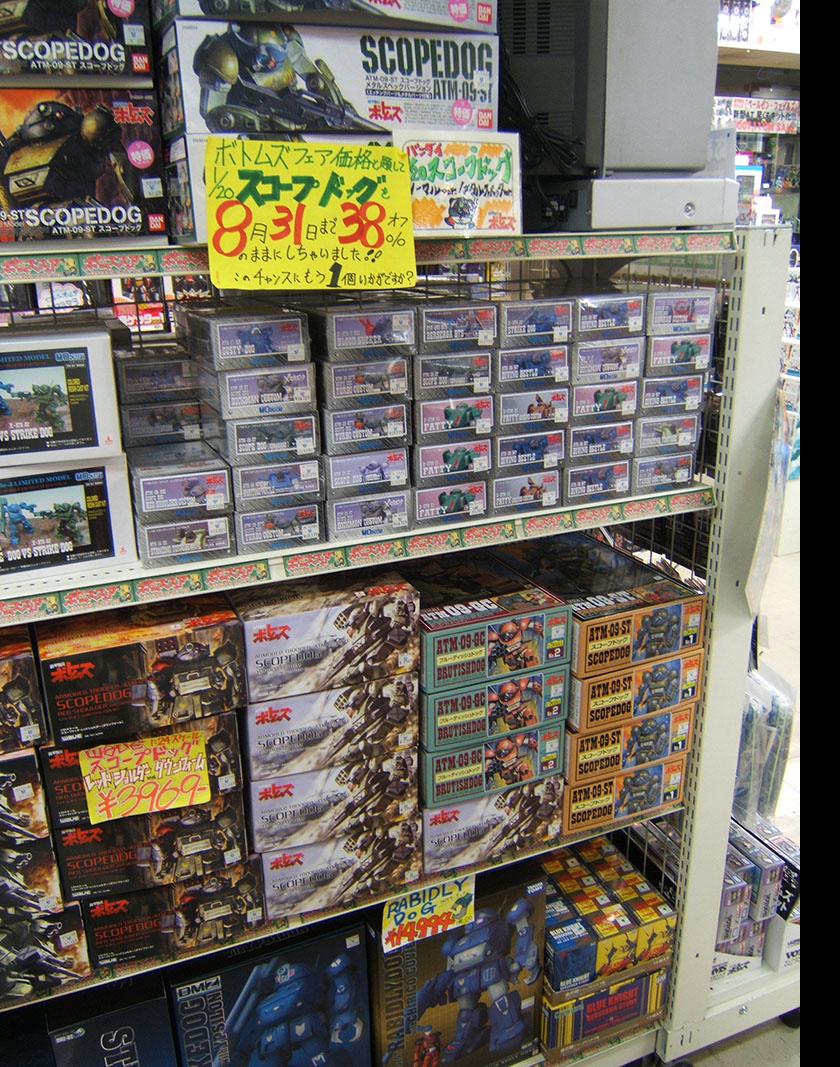
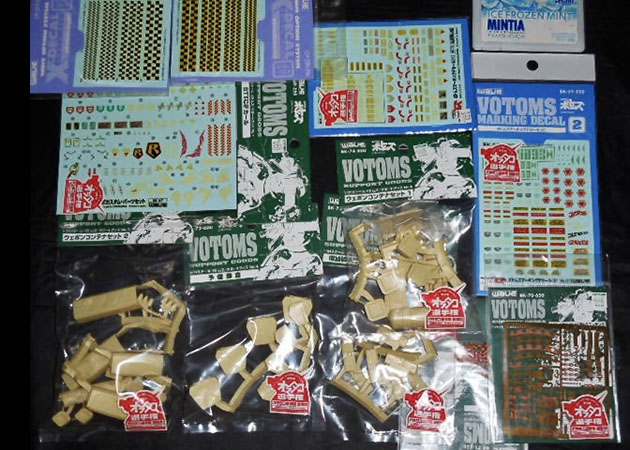
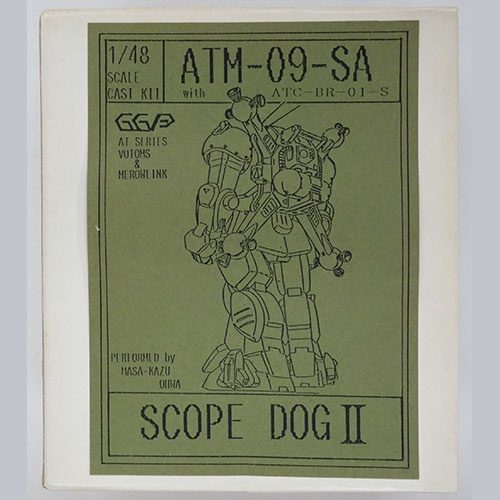
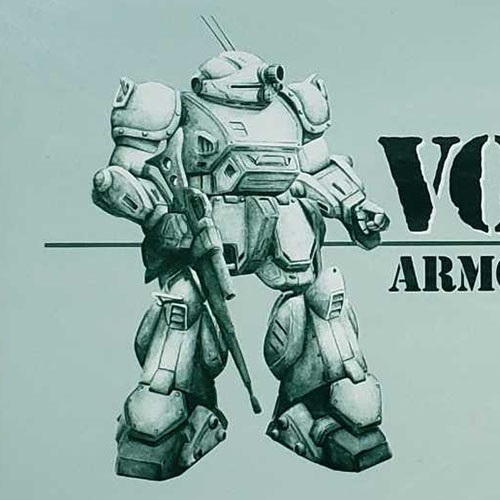
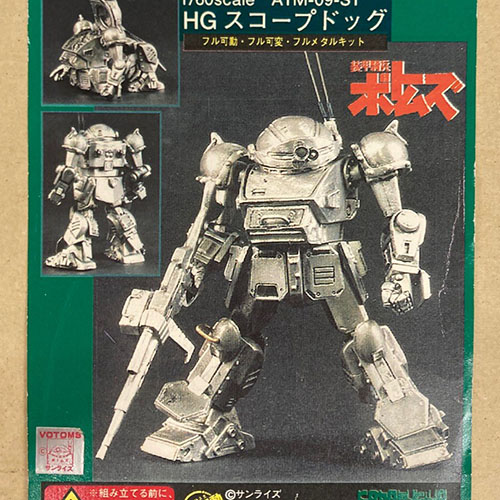
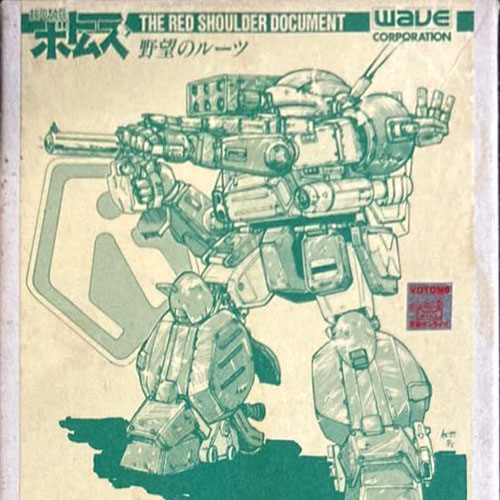
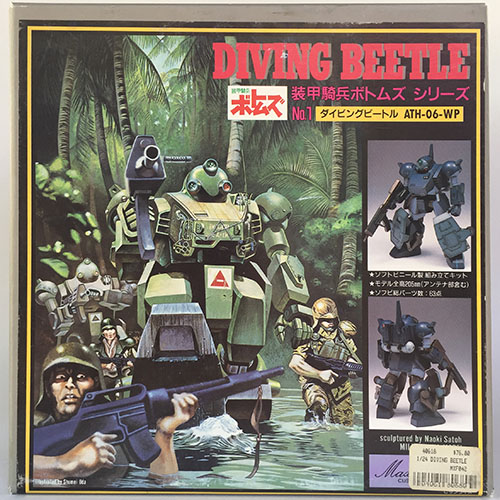
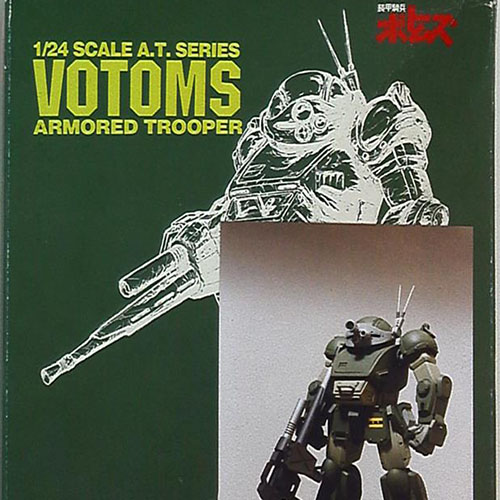
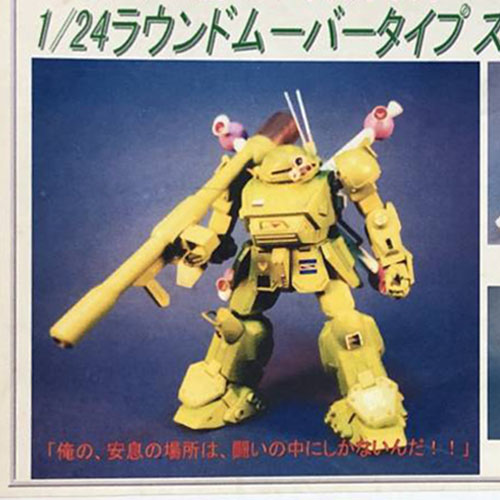
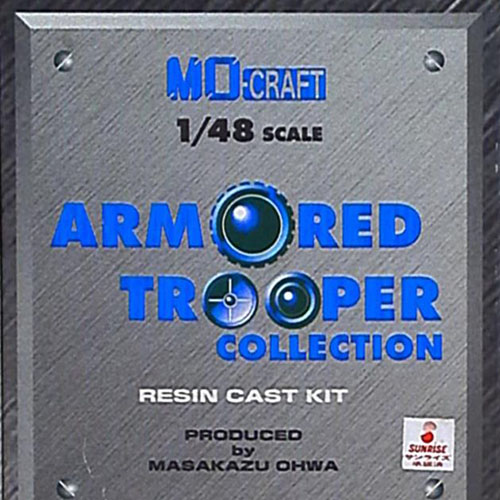
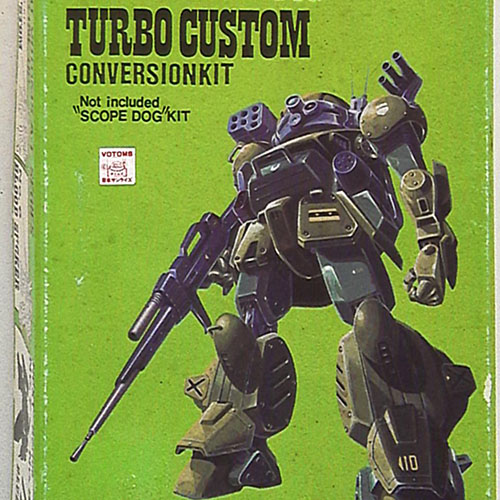
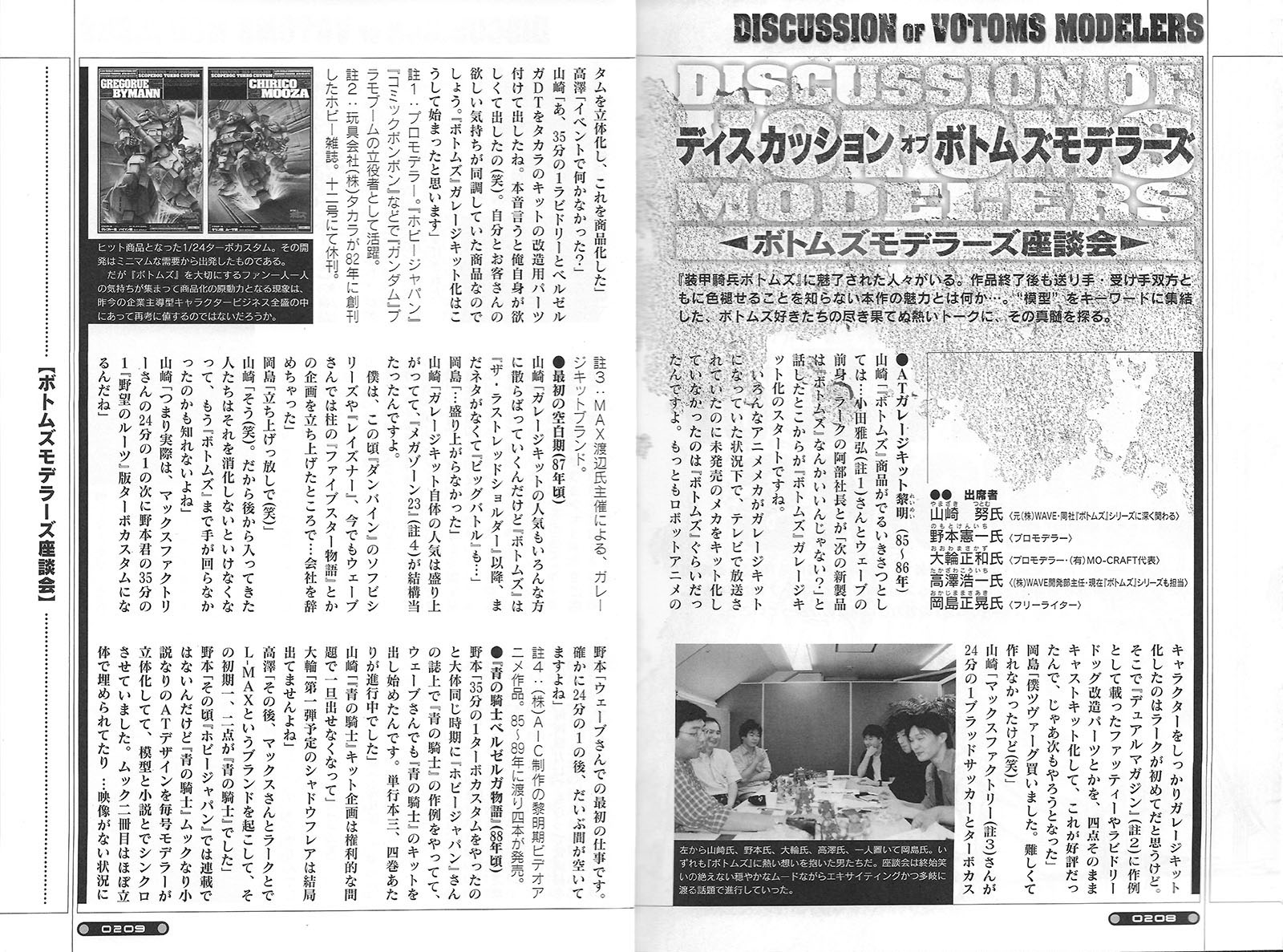
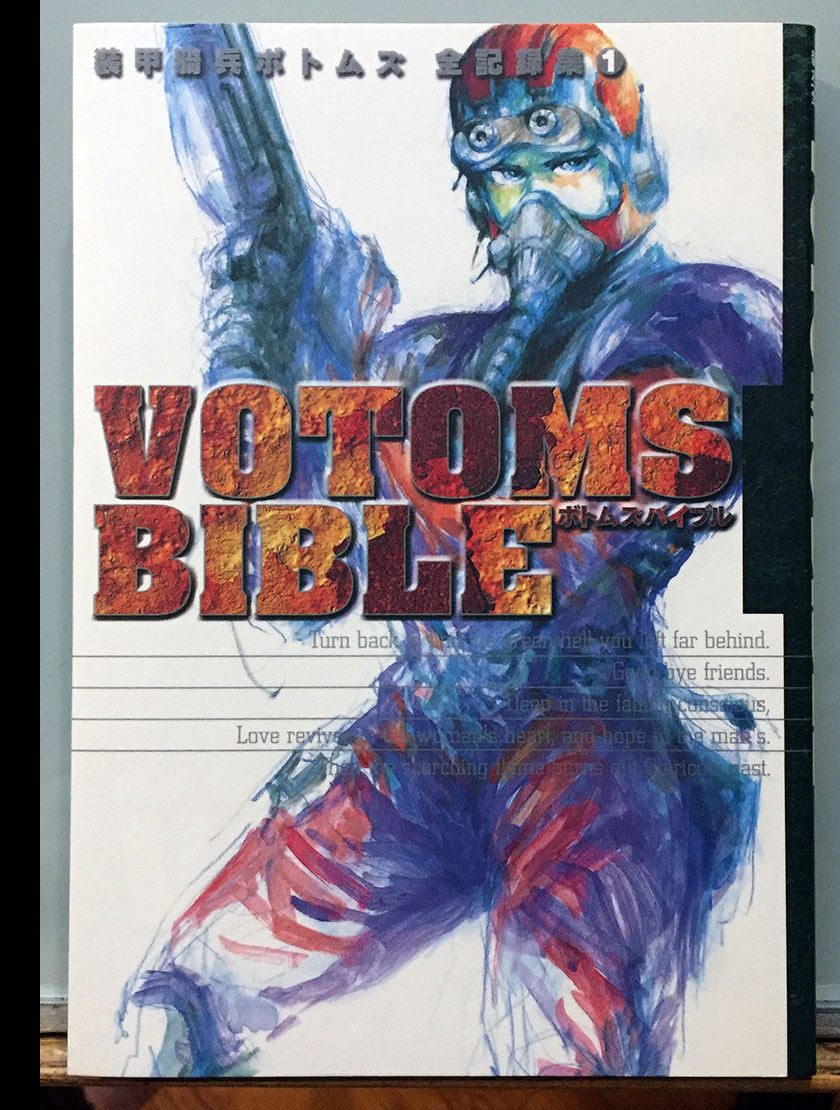

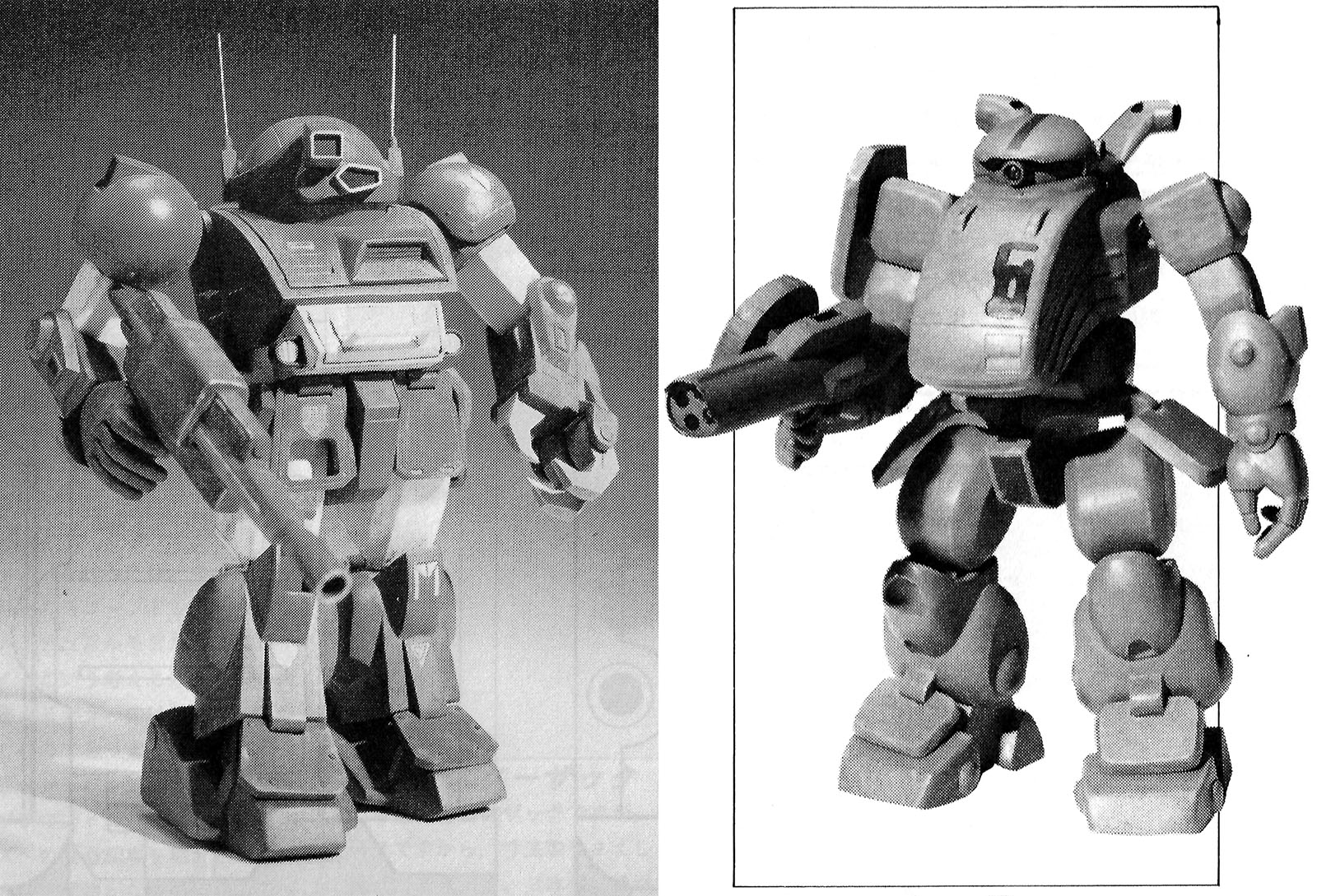
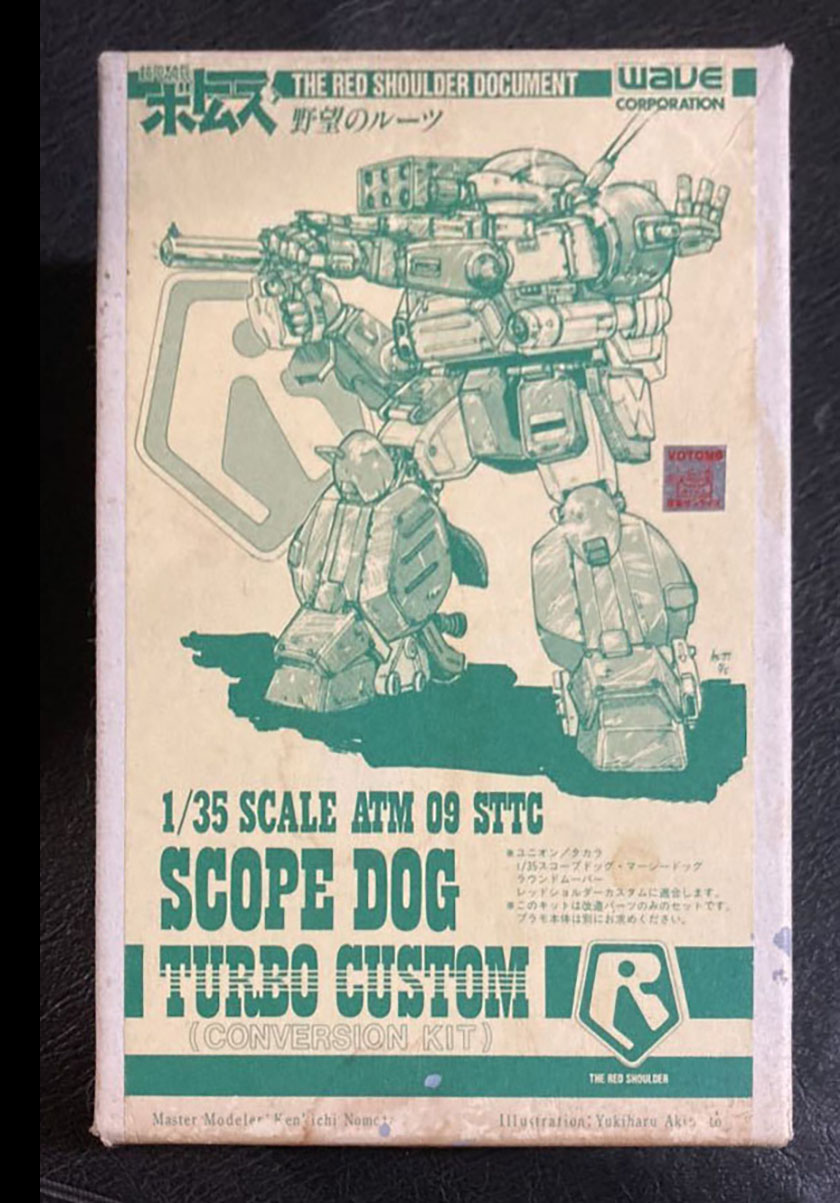
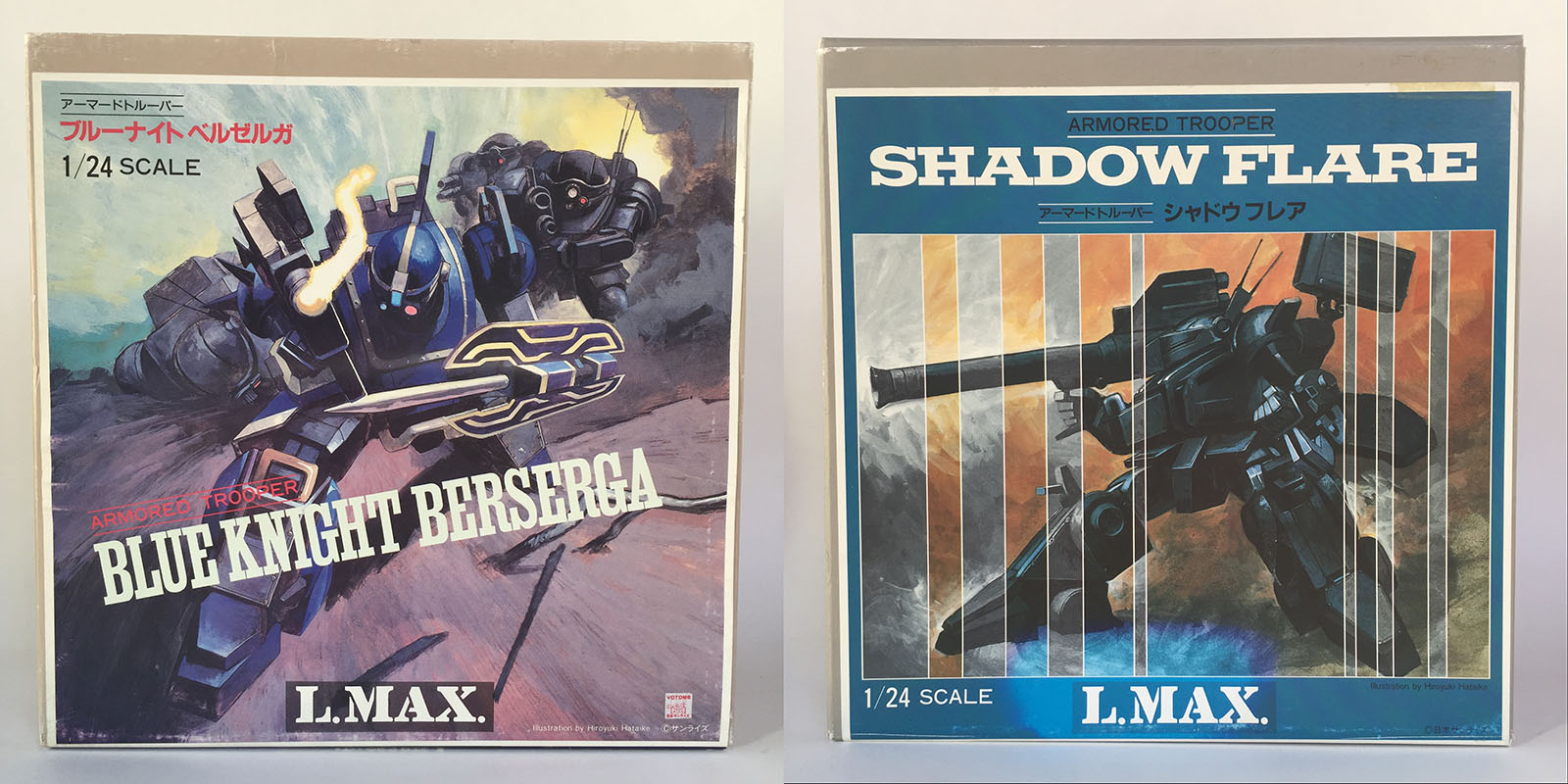
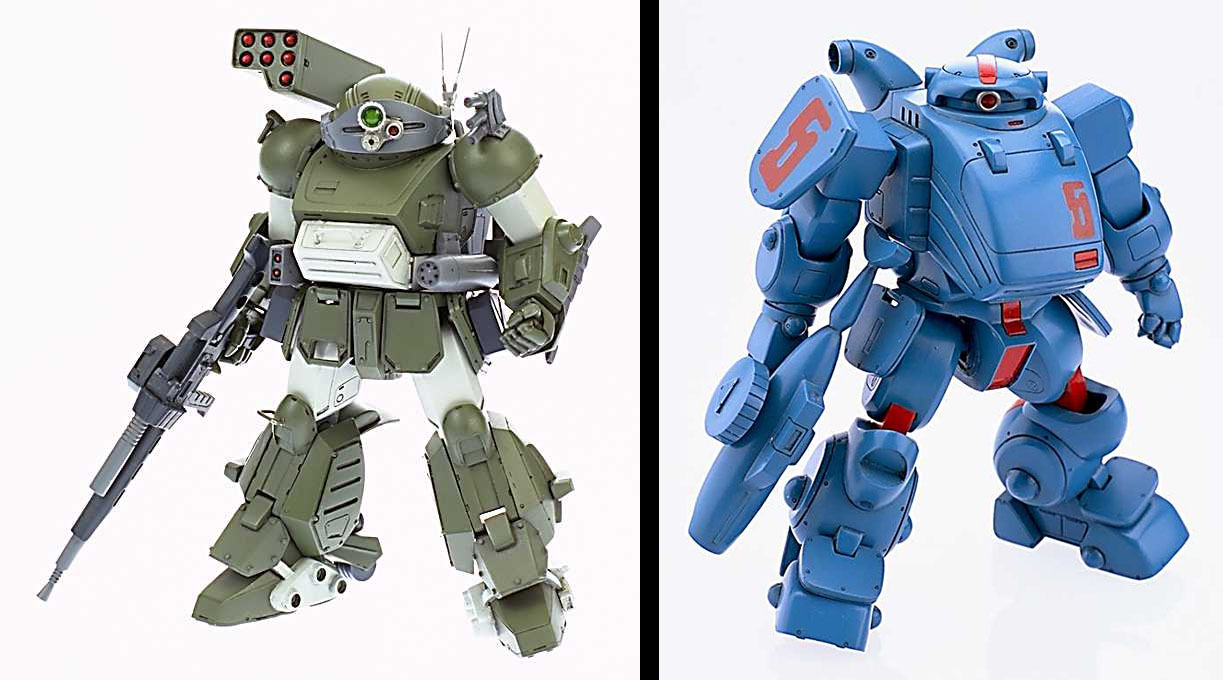
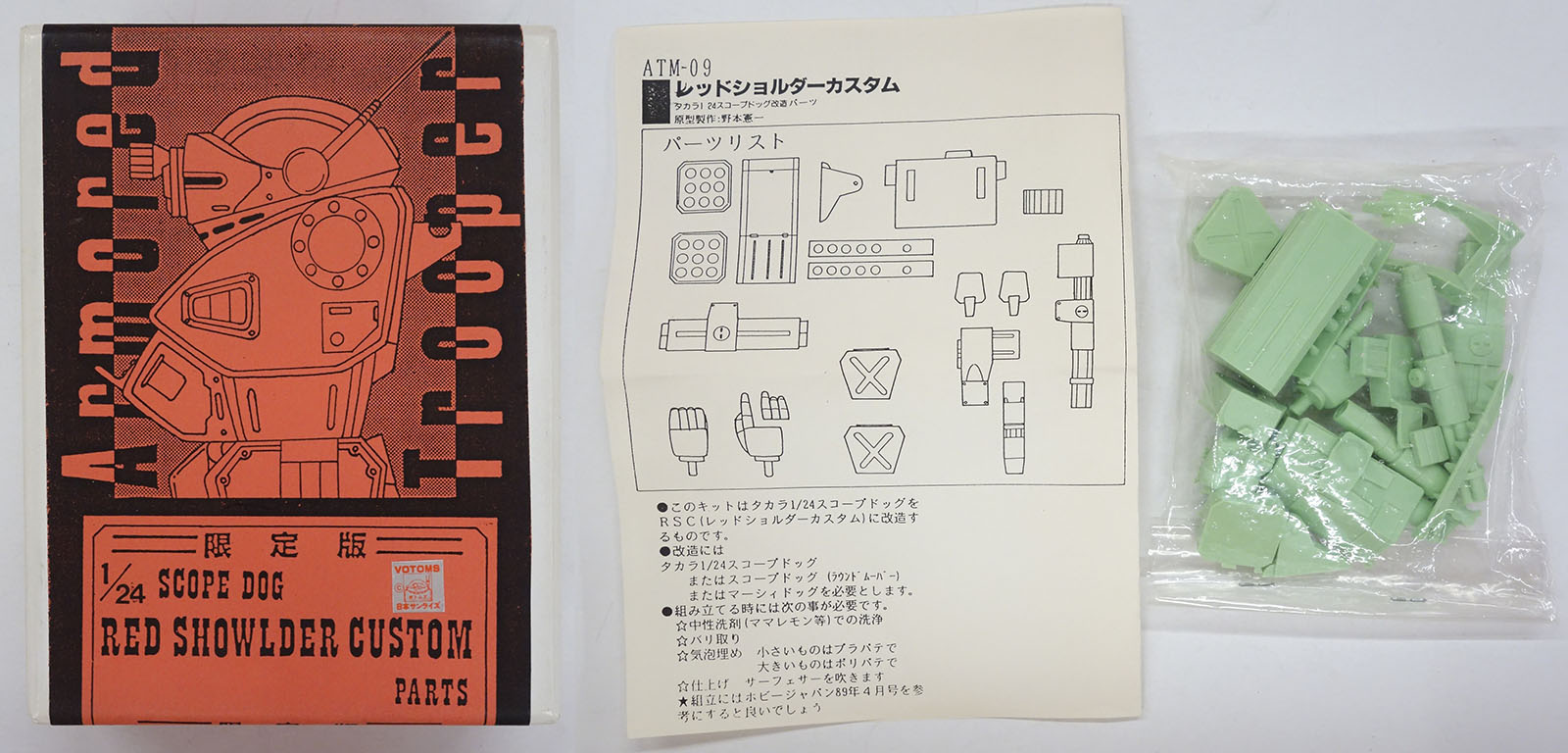
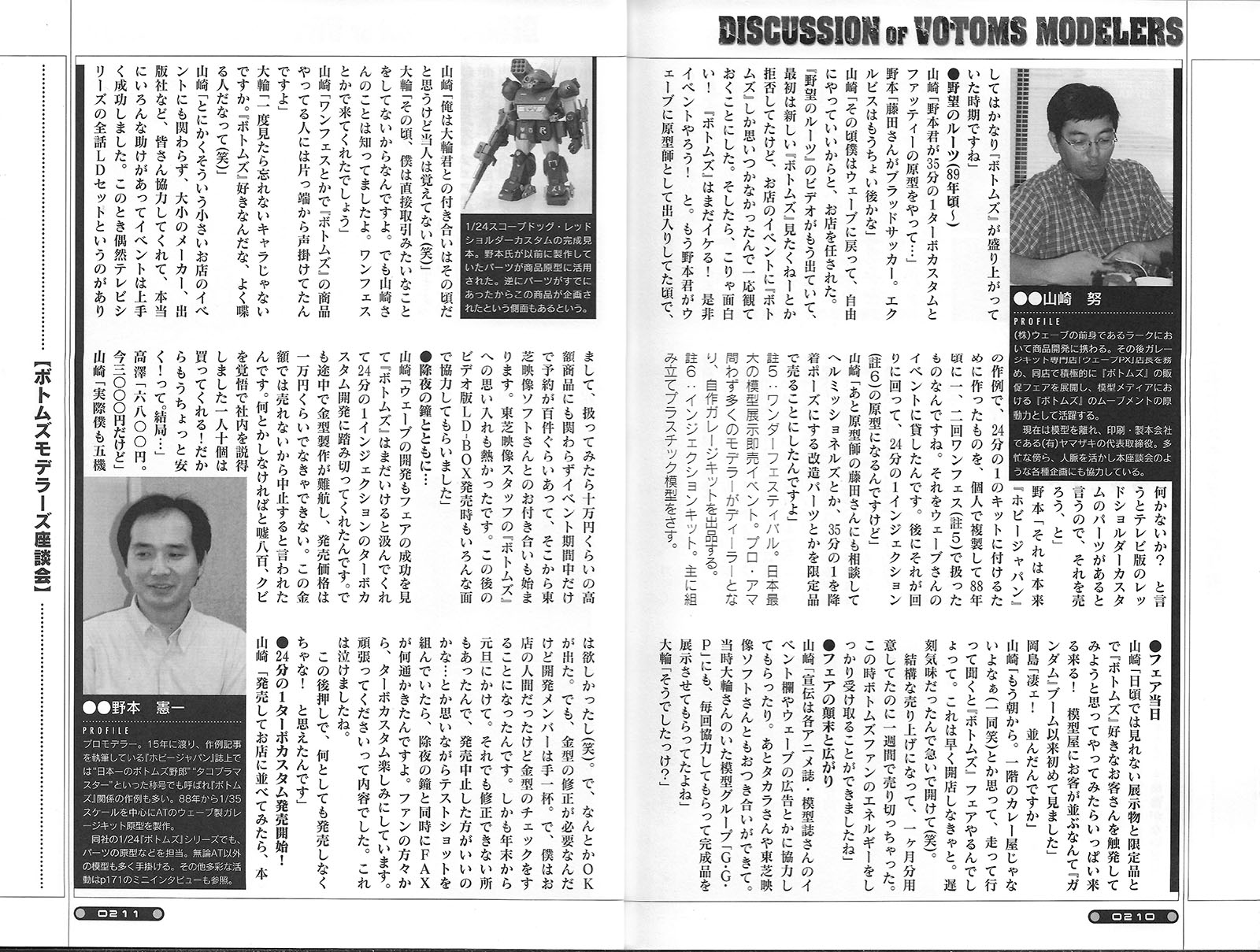
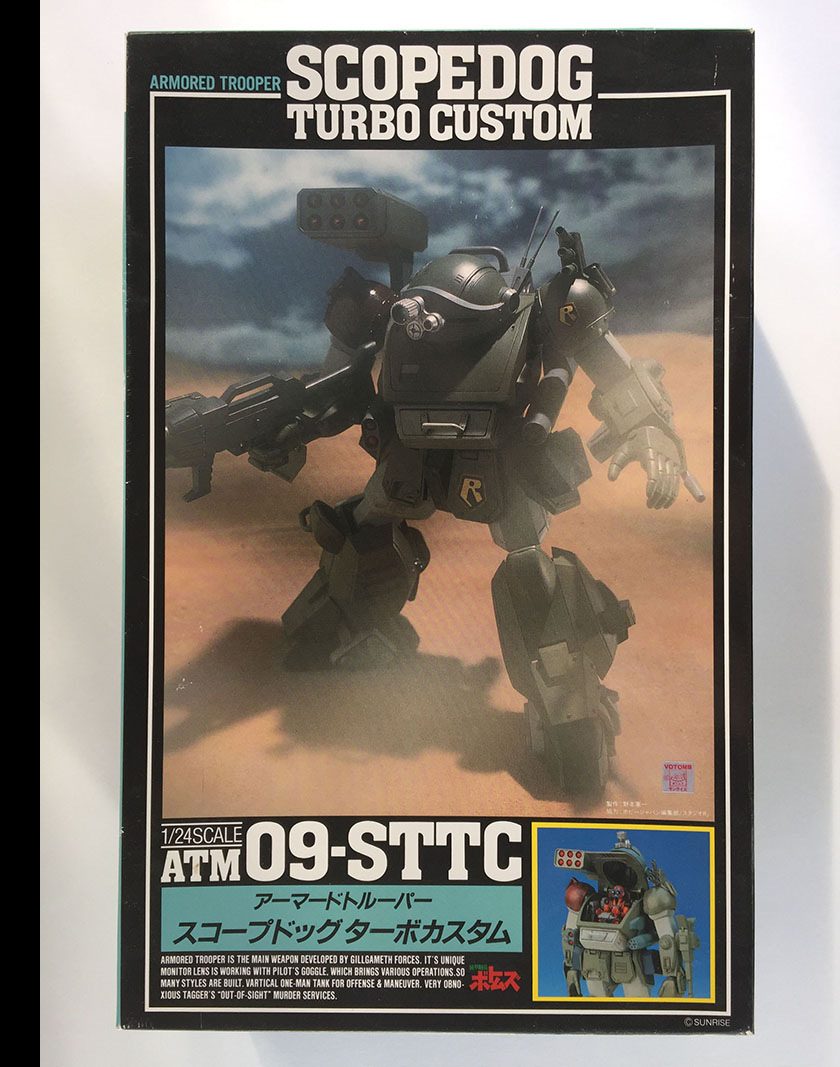
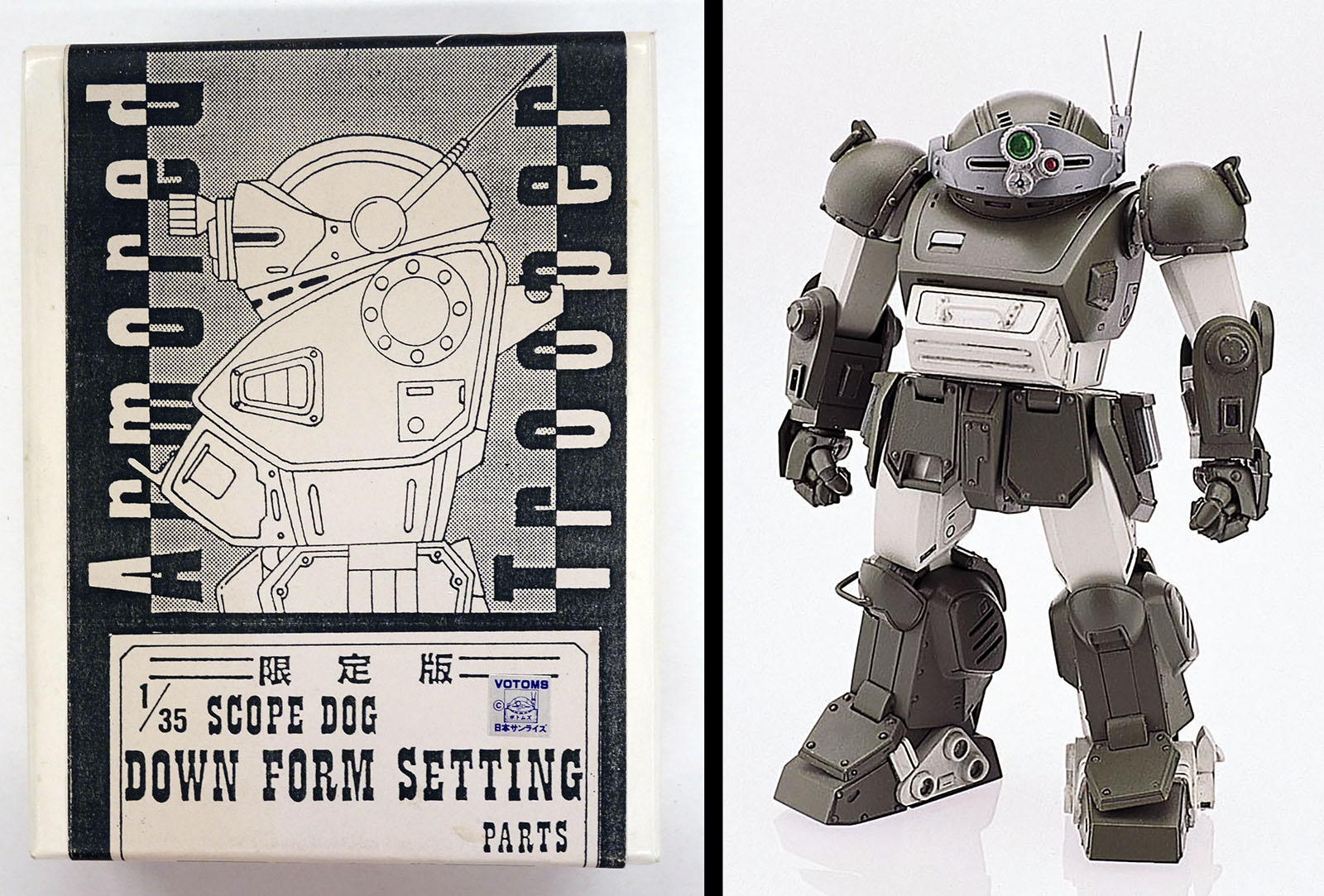
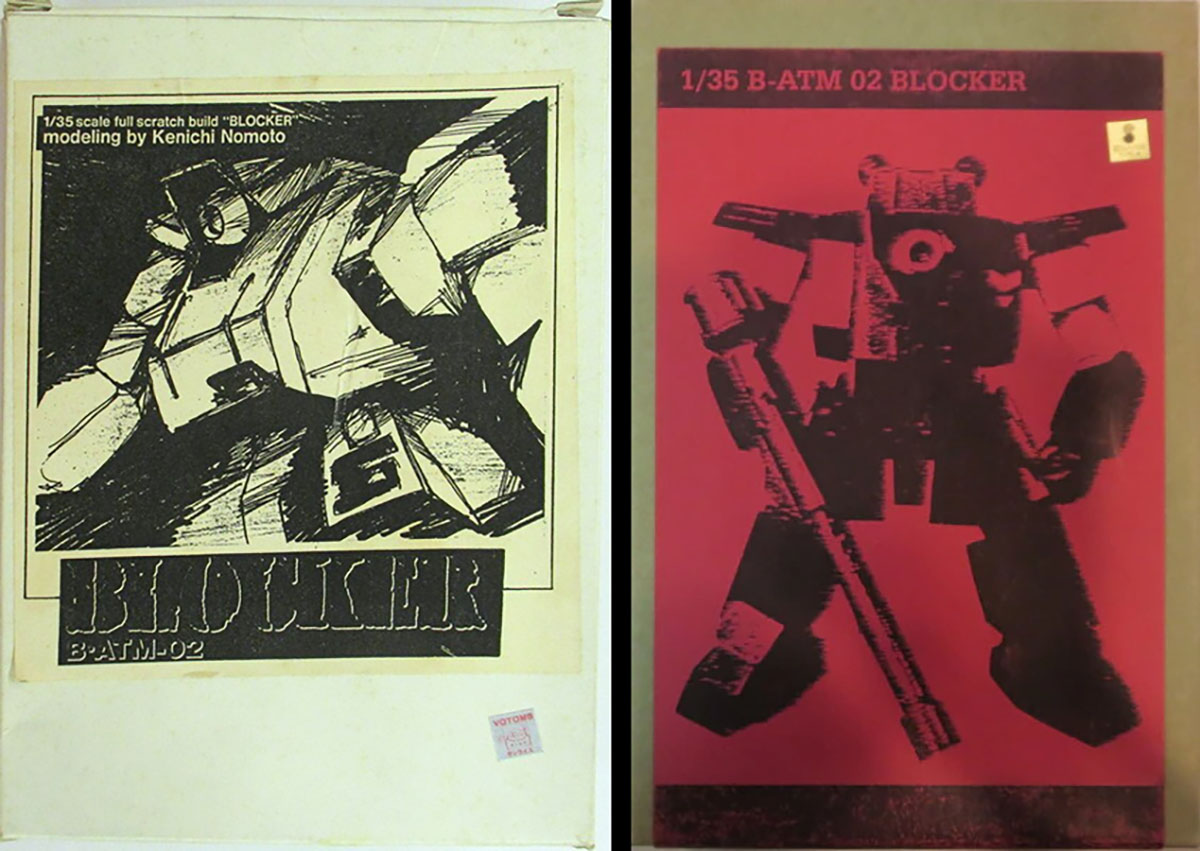
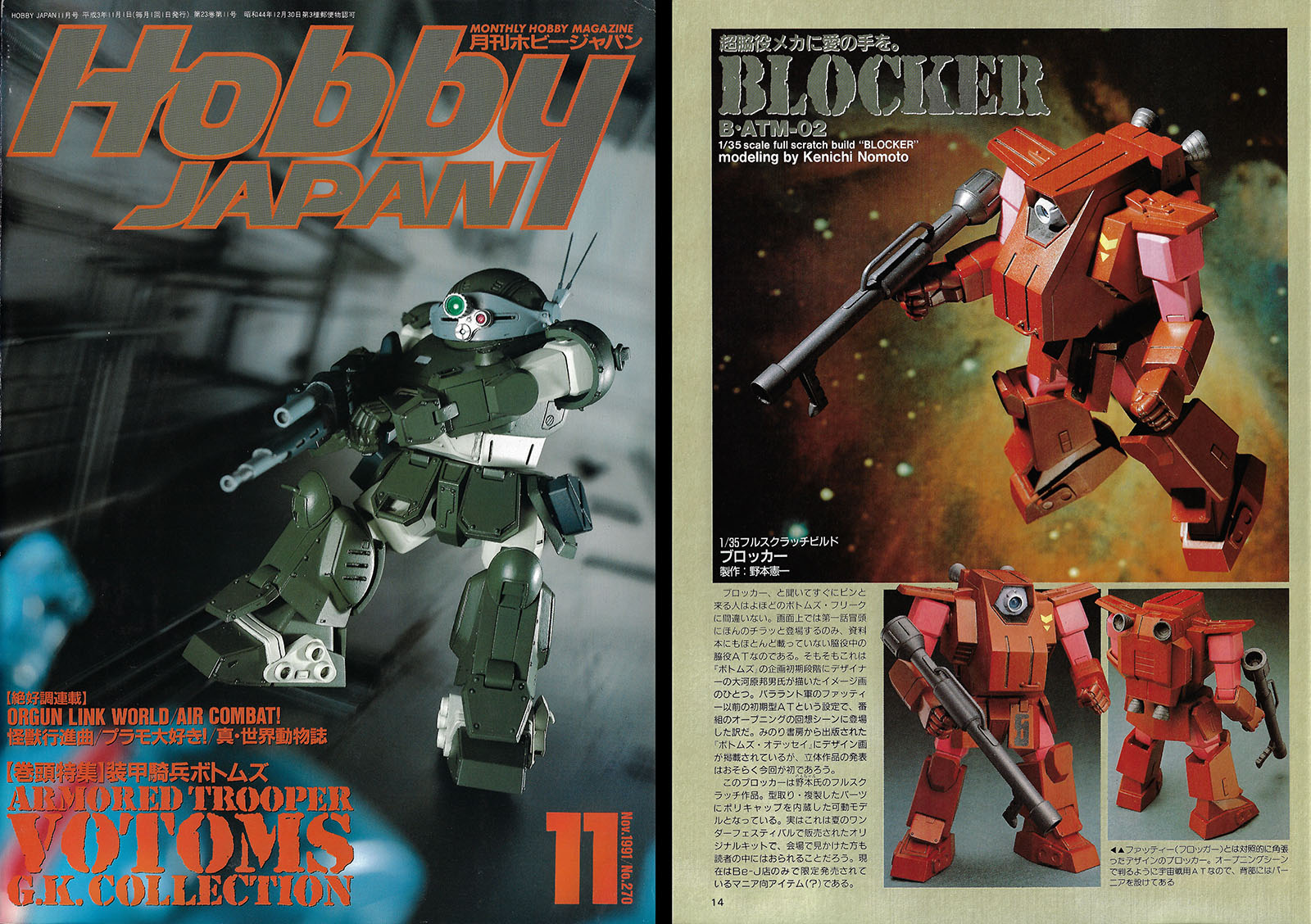
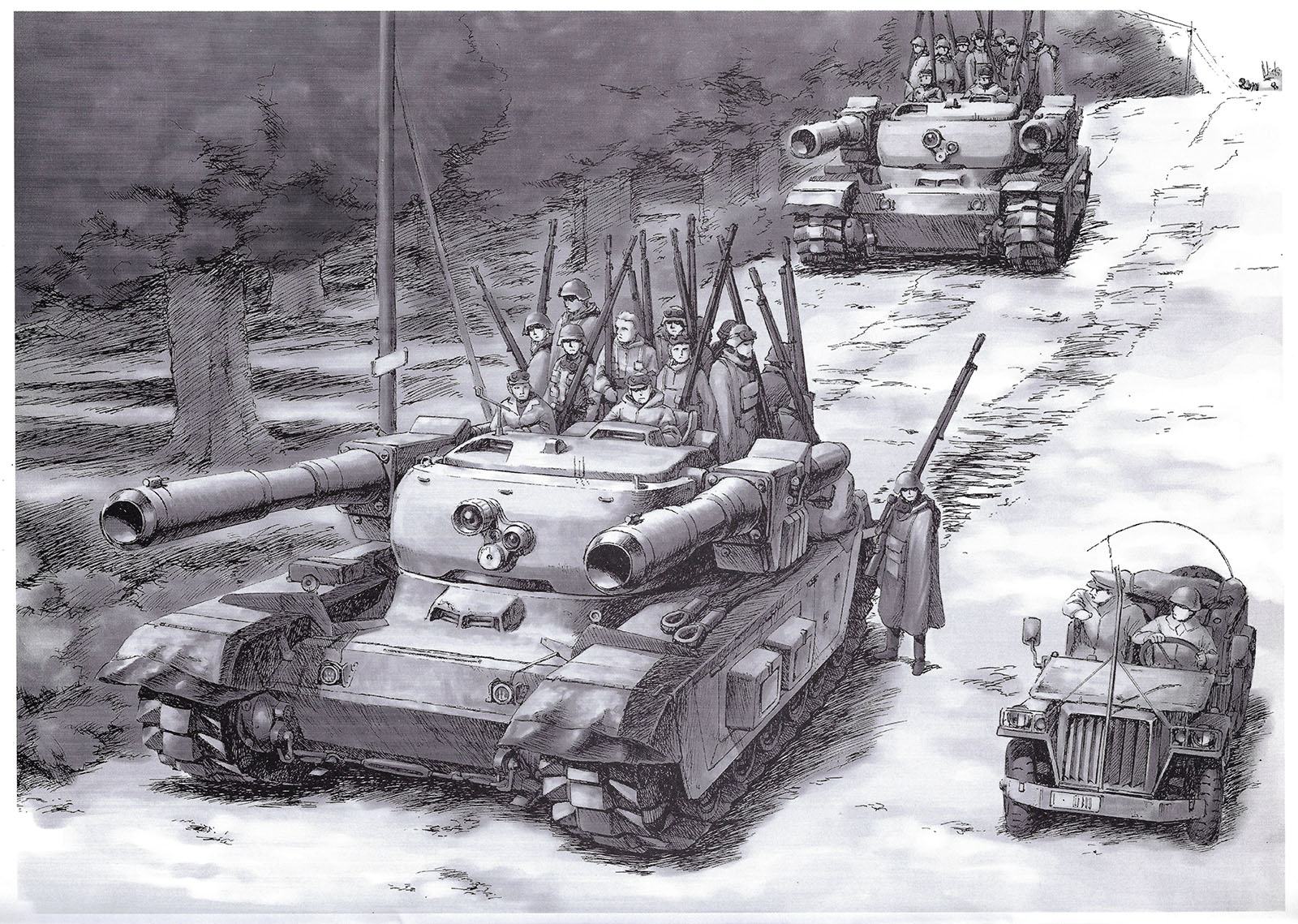
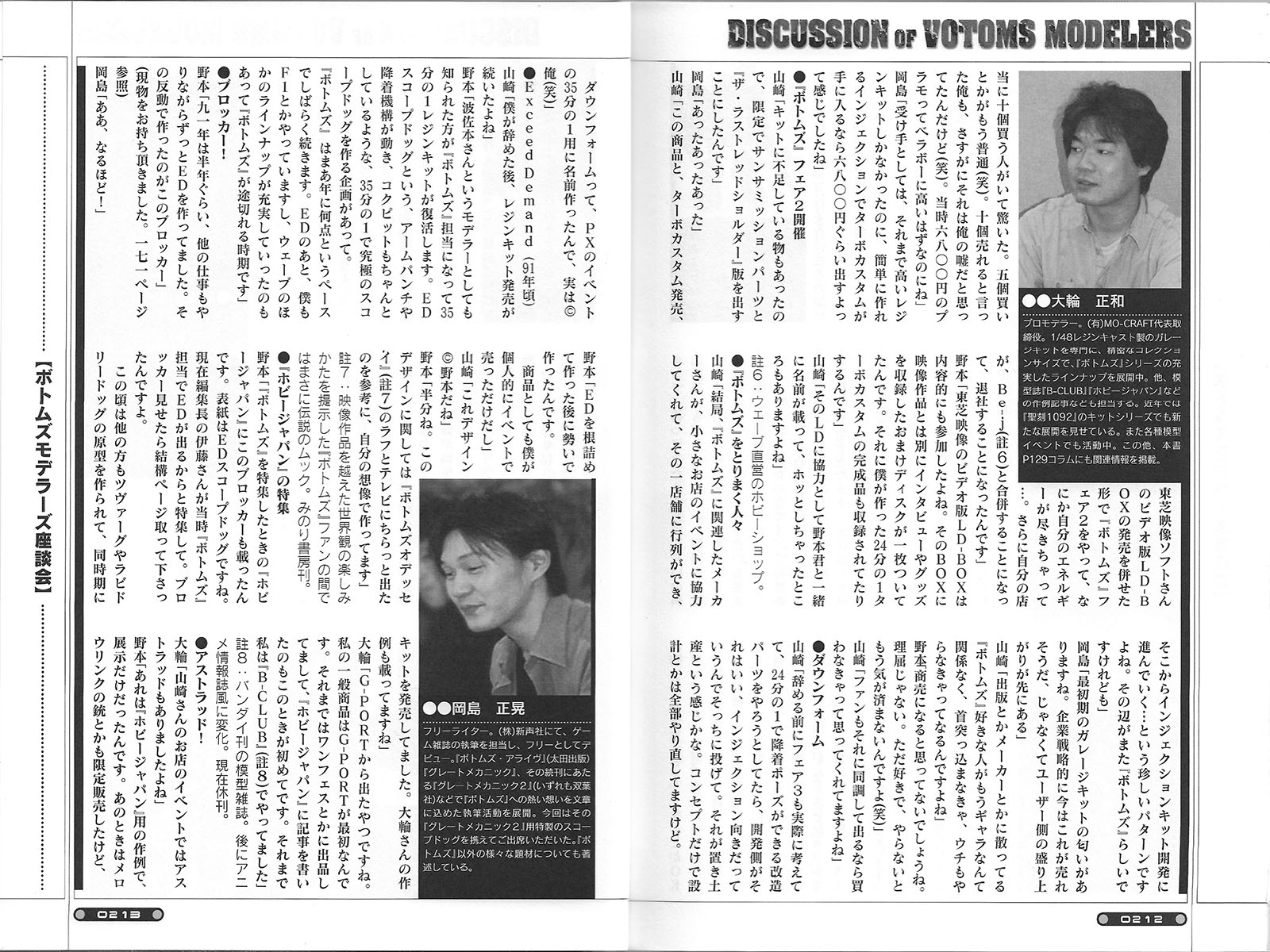
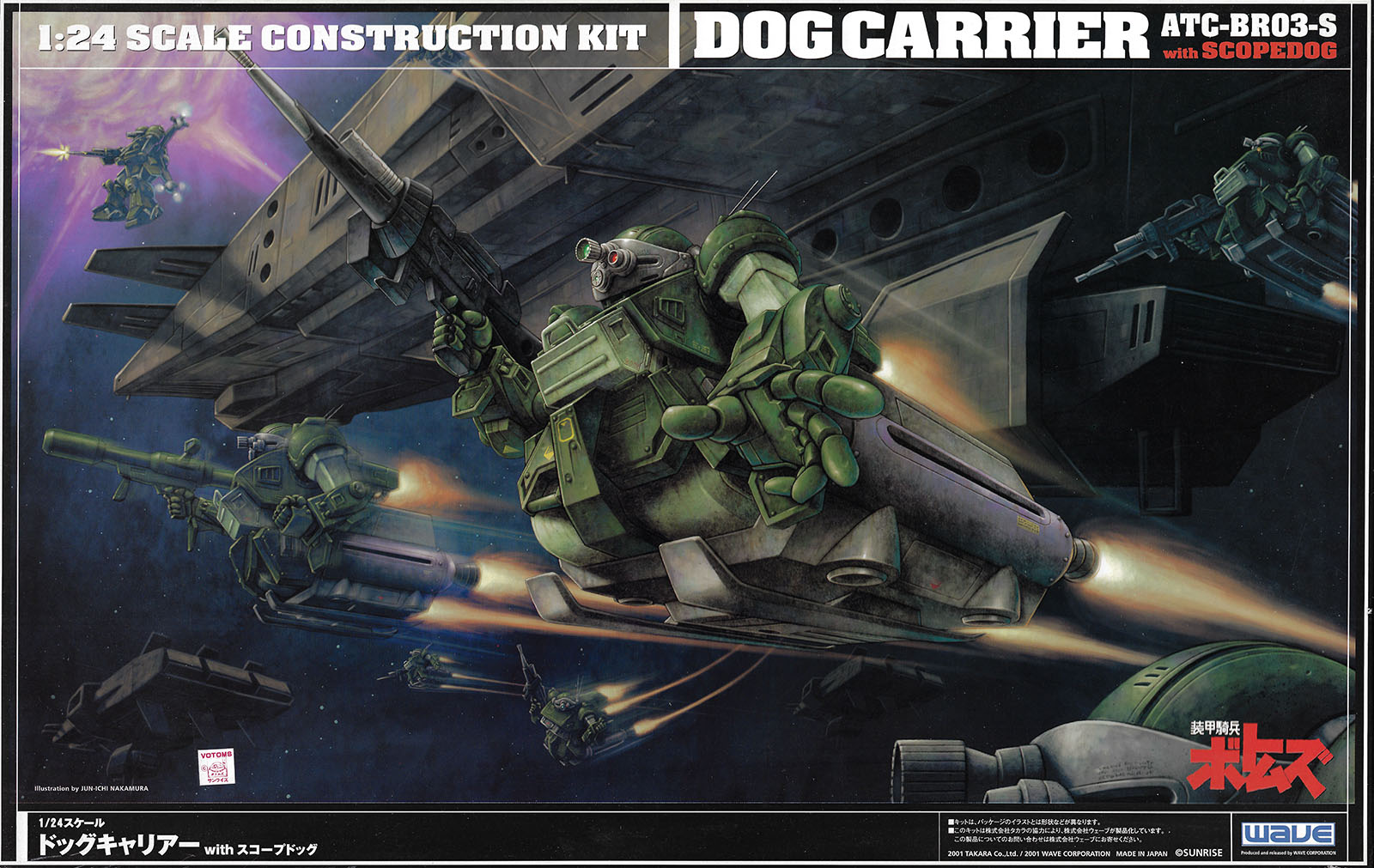
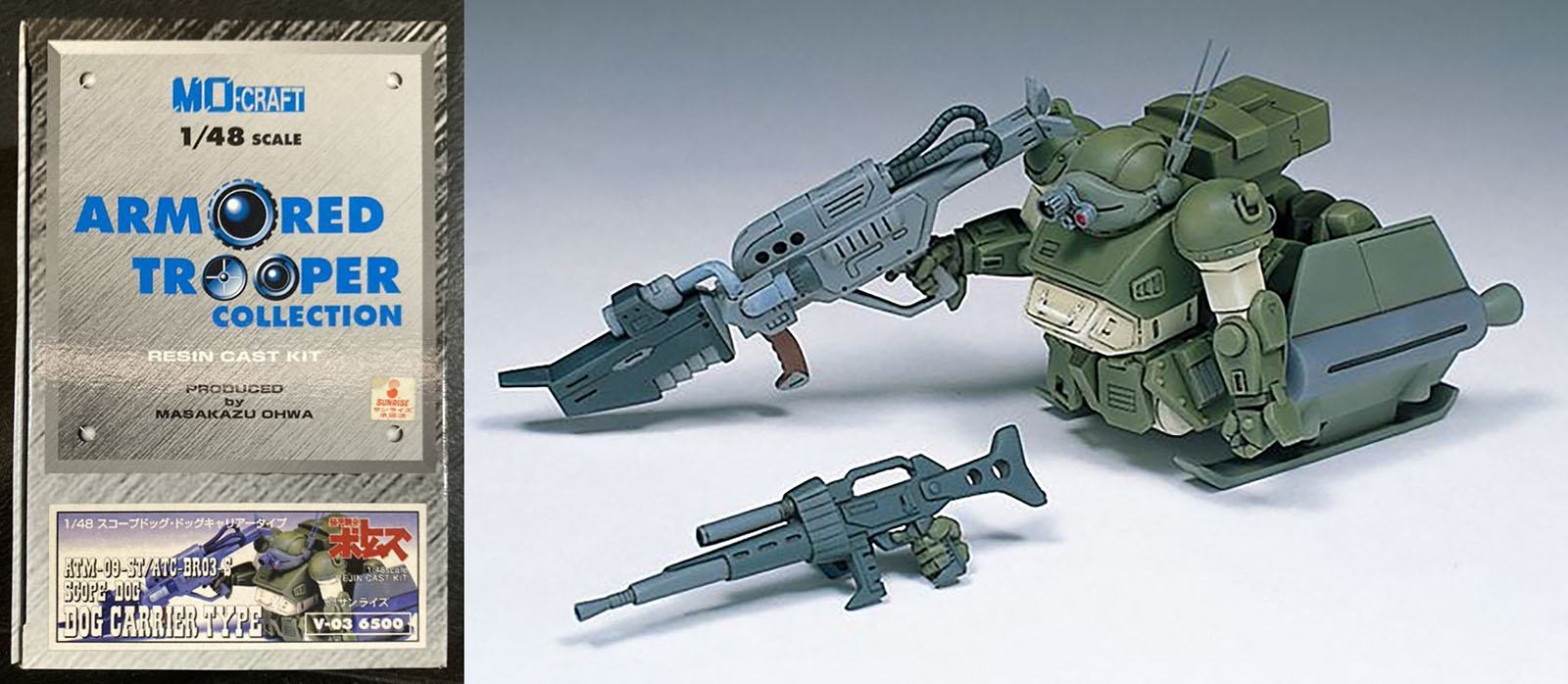
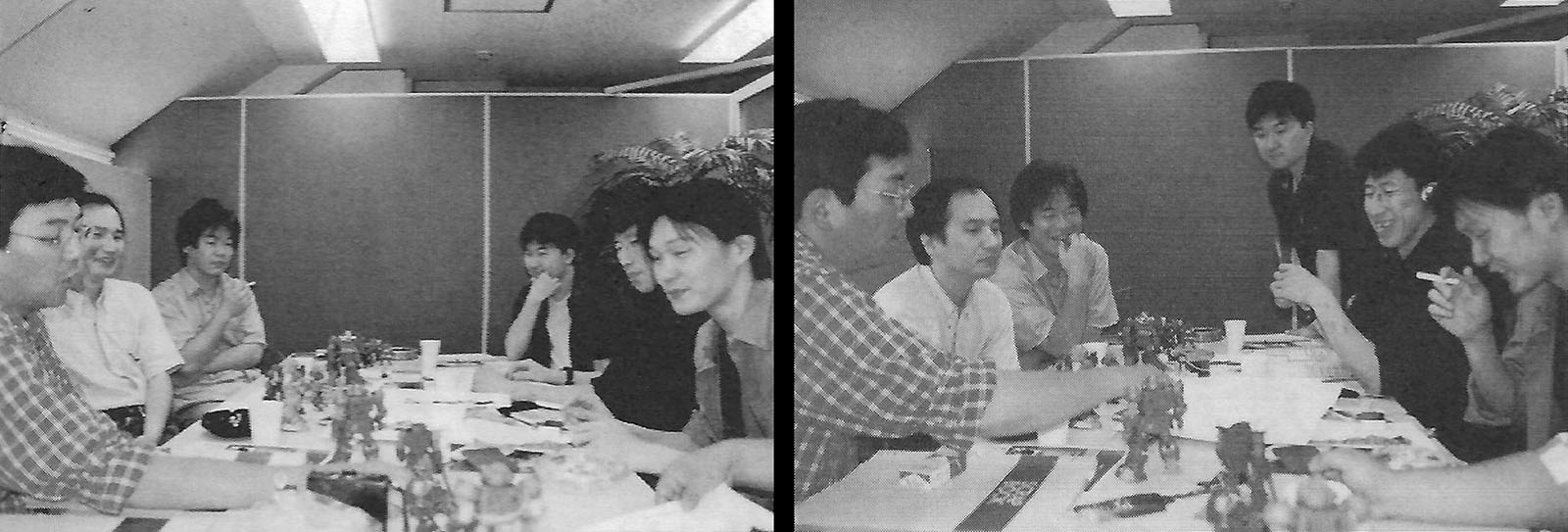
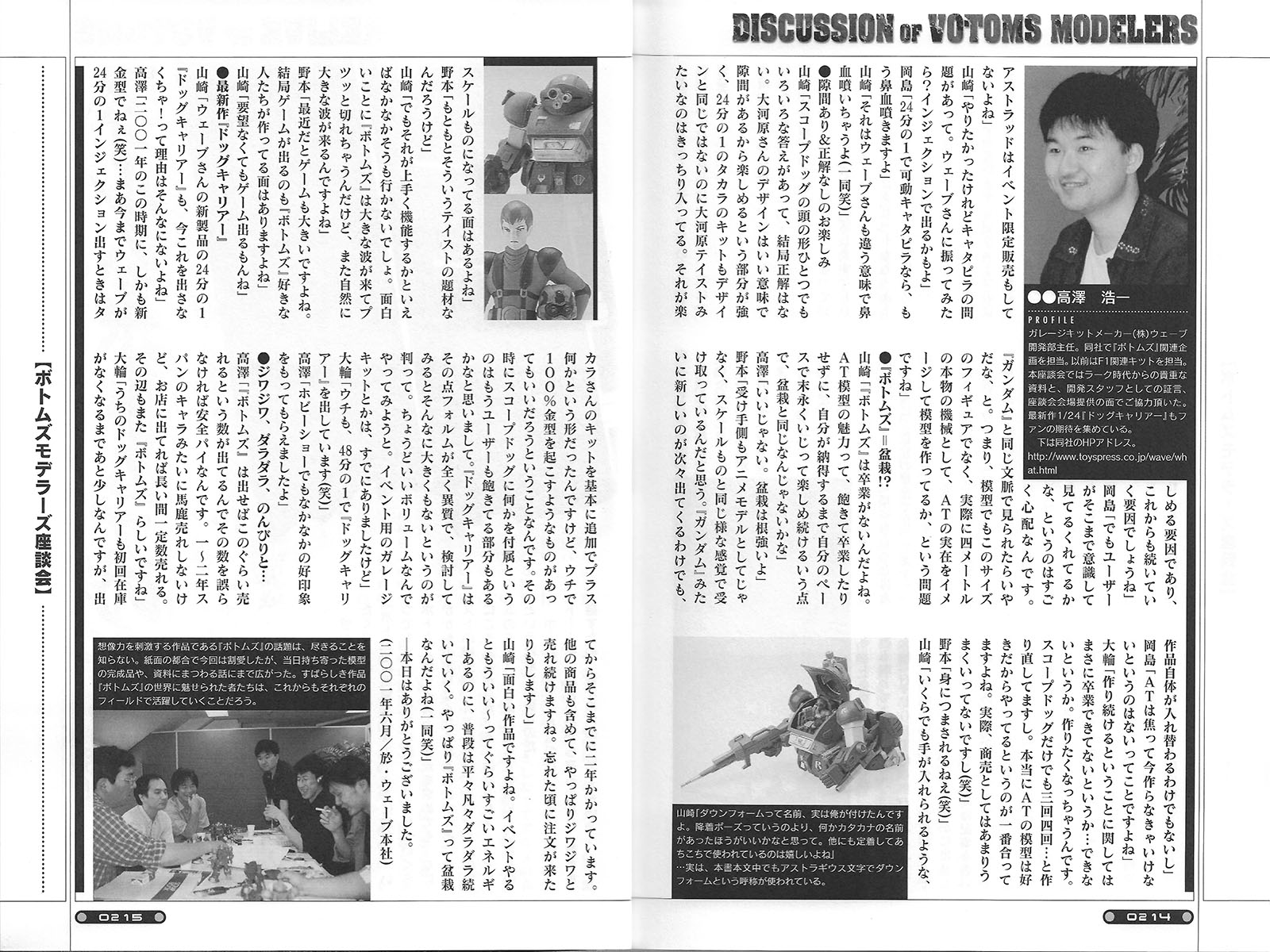
Is the GIGA 1/35 Red Shoulder Scopedog a Standard Type or Turbo Custom?
GIGA 1/35 Blood Sucker:
https://order.mandarake.co.jp/order/detailPage/item?itemCode=1124220317
GIGA 1/35 Brutishdog:
https://order.mandarake.co.jp/order/detailPage/item?itemCode=1095287660
GIGA 1/35 Strikedog:
https://order.mandarake.co.jp/order/detailPage/item?itemCode=1034232146
GIGA 1/35 Rabidlydog (only ¥49,500!):
https://www.amazon.co.jp/-/en/Armored-Trooper-Bottoms-ATH-02-DT-Unassembled/dp/B09TSHC7SB/
GIGA 1/35 Berserga Super Execusion:
https://order.mandarake.co.jp/order/detailPage/item?itemCode=1112446568
GIGA 1/35 Altro (not exactly vintage):
https://order.mandarake.co.jp/order/detailPage/item?itemCode=1183957111
Thanks! The Red Shoulder Scopedog I located is a non-turbo.
GIGA 1/35 Liman Custom:
https://auctions.afimg.jp/r1046198901/ya/image/r1046198901.2.jpg
Dragoon 1/35 ATM-09-STFX, this is my favorite VOTOMS garage kit of all time (designed by GIGA AKA Masayuki Imai):
https://www.suruga-ya.jp/product/detail/603123392
There’s definitely also a GIGA 1/35 Scopedog II but I haven’t found a picture.
To demonstrate that Dragoon and GIGA are both Masayuki Imai:
https://auctions.c.yimg.jp/images.auctions.yahoo.co.jp/image/dr000/auc0303/users/d0d0b8e256e37dfd7b2f4831a0485decd7c7edde/i-img898x1198-1647699928znjbt5663759.jpg
Manten Koubou also made at least three of these ‘Real Deforme’ non-poseable kits:
Scopedog Turbo Custom:
https://auctions.c.yimg.jp/images.auctions.yahoo.co.jp/image/dr000/auc0207/users/6c138cb0fa956b1c0a94acde5afc68544eda4be9/i-img1200x900-1625320185eoxmyc27180.jpg
Bloodsucker:
https://auctions.c.yimg.jp/images.auctions.yahoo.co.jp/image/dr000/auc0207/users/6c138cb0fa956b1c0a94acde5afc68544eda4be9/i-img1200x900-1625319887oki3ux297015.jpg
Rabidlydog:
https://auctions.c.yimg.jp/images.auctions.yahoo.co.jp/image/dr000/auc0207/users/6c138cb0fa956b1c0a94acde5afc68544eda4be9/i-img1200x900-1625320339g44sre14928.jpg
How did you know my catalog of “deform” toys & models is coming next?
I give 2 thumbs up and 2 toes up to that!